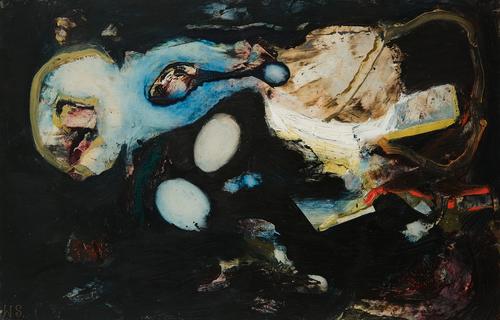
Primordial Language
http://www.hollistaggart.com/exhibitions/primordial-language
William Scharf’s visual language is steeped in myth and mystery, equal parts surrealist, biomorphic, and something wholly his own. His darkly atmospheric canvases reveal jewel-toned or bone white forms that seem to float in a primordial ether or emerge from prehistoric darkness. Like many of his friends and contemporaries in post-war New York, Scharf tapped into universal ideas of mythology and symbolism to access foundational principles of visual experience. His organic forms bring to mind the actions of creation, destruction, and propagation -- actions common to all living things throughout history and yet uniquely shaded in mystery and wonder.
Coming of age in the heyday of New York’s Surrealist and Abstract Expressionist movements, Scharf developed interests in the careful paint handling, rich color, and heady symbolic language that characterized much of the art of his time. A close friendship with Mark Rothko in particular solidified his interest in color and his philosophical approach to his work. Scharf’s style developed into something immediately recognizable, a unique combination of visual transcendence and quiet moments of beauty. Potent symbols -- the egg, the eye, the cross -- recur throughout his oeuvre, teaching viewers to see his paintings as part of a larger fabric of universal mythos, even as a conduit to an understanding of those omnipresent ideas.
This style crystallized early in Sharf’s career, as evidenced in a series of small canvases from the mid-1960s first shown at Betty Parsons Gallery in New York. Works such as Hole Place and Lid’s Night distil the free-flowing brushwork of the New York School into discrete vignettes of glowing form, each emerging from the shadowed plane like a luminescent creature from the quiet depths. These forms coalesce into compositions that function like contained ecosystems, small aquarium glimpses into a larger, grander, and more wonderful world.
William Scharf lived and worked in New York from 1952 until his death in 2018. He relocated to the city from his native Pennsylvania at the recommendation of his friend and mentor N.C. Wyeth, who had encouraged his artistic pursuits since Scharf’s childhood. Studies at the Pennsylvania Academy of the Fine Arts, the Barnes Foundation, and the Académie de la Grand Chaumière prepared him for a lifetime of painting in the nation’s artistic capital. He exhibited regularly over the intervening decades, most recently at MoMA PS1 in Queens, the Frederick R. Weisman Museum of Art in Malibu, and the Phillips Collection in Washington, D.C.
PRESS CONTACT
Ginx Hudgins
press@hollistaggart.com
212.628.4000
- Contact:
- Ginx Hudgins
- ginx@hollistaggart.com
- 2126284000

100x100_n.jpg)
100x100_c.jpg)












100x100_c.jpg)